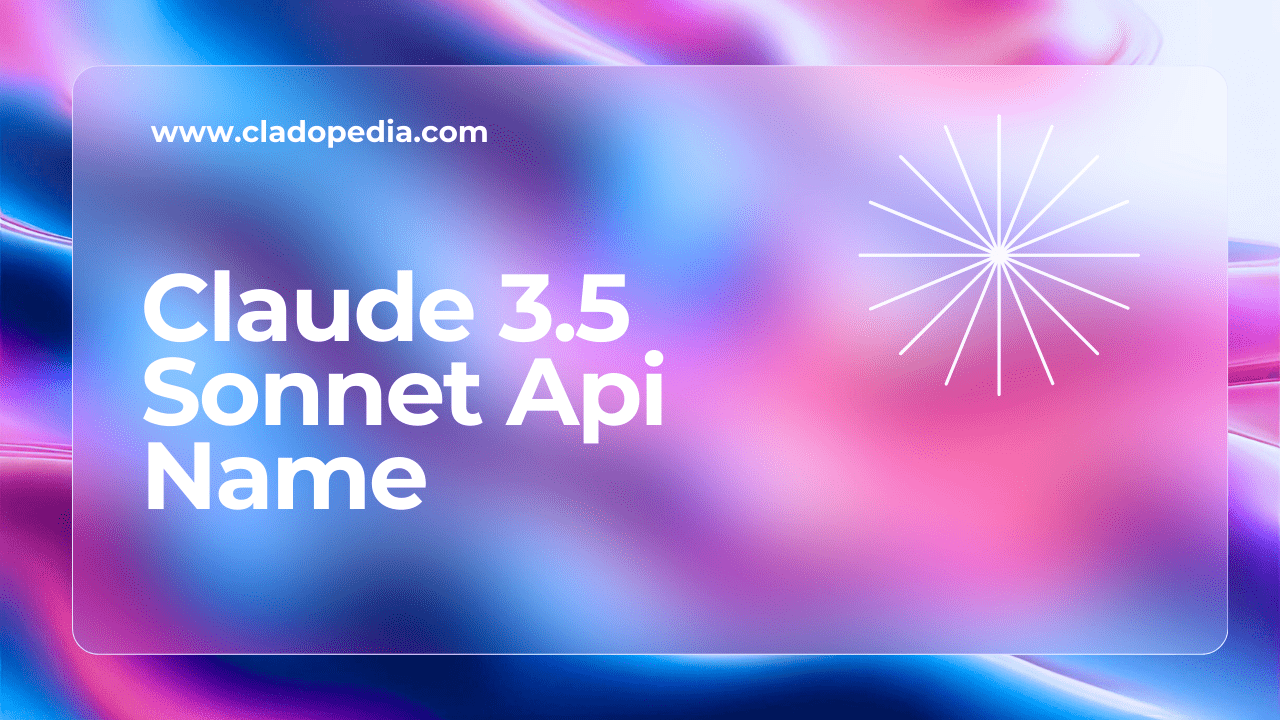Claude 3.5 Sonnet Api Name . The Claude 3.5 Sonnet API represents a significant leap in natural language processing and AI capabilities. As part of the Claude 3.5 ecosystem, the Sonnet API is designed to offer seamless integration, allowing developers, researchers, and businesses to harness the full potential of advanced AI technology. This article will break down the Claude 3.5 Sonnet API by looking into its features, technical aspects, use cases, and how it stands out in the ever-growing field of AI-driven APIs.
What Is Claude 3.5 Sonnet?
Claude 3.5 Sonnet is an iteration of Anthropic’s Claude model family, a sophisticated AI model capable of handling complex natural language processing tasks, including text generation, summarization, and more. The Sonnet API is specifically crafted to allow users to access Claude 3.5’s capabilities programmatically, offering flexibility and power across multiple applications.
Overview of API Functionality
At its core, the Claude 3.5 Sonnet API serves as a tool to bridge users with Claude 3.5’s NLP capabilities. Through simple requests, developers can integrate these functionalities into their apps, websites, or systems. The API supports numerous requests such as text completion, natural language understanding, and more.
Key Features of the Claude 3.5 Sonnet API
The Claude 3.5 Sonnet API comes with a rich set of features designed to deliver robust functionality in various applications. These features emphasize scalability, security, and ease of use.
1. Advanced Text Generation
Claude 3.5 Sonnet excels in generating human-like text. Whether used for writing assistant software or content generation, the API’s text generation abilities allow for coherent and contextually relevant outputs. The API adapts well to different tones, writing styles, and formalities based on user input.
2. Context-Aware Understanding
A significant feature of the Claude 3.5 Sonnet API is its ability to understand and remember context over extended conversations or interactions. This context-awareness enables smoother human-AI interaction and allows for nuanced, sophisticated outputs.
3. Scalability and Flexibility
The API is scalable and can handle large volumes of requests, making it ideal for both small-scale projects and enterprise-grade applications. With flexible parameters and extensive customization options, the Sonnet API adapts to specific user needs while maintaining optimal performance.
4. Multimodal Capabilities
While primarily focused on text, the Claude 3.5 Sonnet API also extends its capabilities to understand and analyze multimodal inputs, such as images and audio, enabling richer, more versatile applications.
5. Data Privacy and Security
Security is a paramount concern for any AI service. The Claude 3.5 Sonnet API is designed with advanced security protocols, ensuring that data privacy is maintained at all times. Encryption, anonymization, and other security measures are in place to safeguard sensitive information.
Claude 3.5 Sonnet API: Architecture and Design
The Claude 3.5 Sonnet API is built on a robust cloud-based architecture designed to ensure high availability, low latency, and smooth operation even under high demand. The API uses a combination of cutting-edge AI models, optimized algorithms, and cloud infrastructure.
1. Model Architecture
The Claude 3.5 Sonnet API utilizes transformer-based architectures, which form the backbone of modern natural language processing systems. The API leverages large language models (LLMs) trained on vast datasets, allowing it to perform a variety of tasks with remarkable accuracy.
2. Data Flow and Processing
When a request is made to the Sonnet API, the data undergoes preprocessing, where it is tokenized and structured for optimal processing by Claude 3.5. The model then generates a response, which is post-processed before being sent back to the user.
3. API Endpoints
The Claude 3.5 Sonnet API provides several endpoints tailored to different use cases:
- Text Generation: Generate human-like text based on a prompt.
- Summarization: Condense lengthy content into concise summaries.
- Text Classification: Categorize text into predefined labels or groups.
- Sentiment Analysis: Understand the emotional tone of a text.
4. Error Handling and Logging
The API is equipped with advanced error-handling mechanisms. Users are notified of issues such as rate-limiting, invalid requests, or server errors. Logging mechanisms are also provided, which helps in debugging and monitoring performance.
Use Cases for Claude 3.5 Sonnet API
The Claude 3.5 Sonnet API is versatile and applicable across a wide range of industries and tasks. Its capabilities can be leveraged to revolutionize how businesses interact with customers, analyze data, and optimize workflows.
1. Content Generation and Copywriting
With its ability to generate coherent and contextually accurate text, the API can be a powerful tool for content creators. Whether it’s writing blog posts, marketing copy, or social media updates, Claude 3.5 Sonnet can automate much of the content creation process.
2. Virtual Assistants and Chatbots
The API can be embedded into virtual assistants and chatbots to improve user engagement. Its natural language understanding ensures that interactions feel human-like, enhancing the overall customer experience.
3. Data Analysis and Insights
Businesses can use the API to automatically analyze text data, such as customer reviews or social media sentiment. The text classification and sentiment analysis capabilities of the API provide actionable insights from vast amounts of unstructured data.
4. Customer Support Automation
With the ability to process large volumes of natural language requests, the Sonnet API can be used to automate customer support tasks. It can handle common queries, provide relevant answers, and escalate more complex issues to human agents.
5. Education and Learning Platforms
For educational platforms, the Claude 3.5 Sonnet API can create personalized learning experiences. It can generate explanations, quizzes, and provide tutoring based on student input, helping with personalized learning paths.
How to Get Started with the Claude 3.5 Sonnet API
Getting started with the Claude 3.5 Sonnet API is straightforward. Here’s a breakdown of the steps involved:
1. Setting Up Your Account
To access the API, users must create an account with the platform hosting the Claude 3.5 Sonnet API. Once an account is created, developers can obtain their API keys, which will authenticate their requests to the API.
2. API Documentation and Integration
Detailed API documentation is provided, which outlines all the endpoints, parameters, and response formats. Following the documentation is crucial for integrating the API correctly into your application.
3. Making API Requests
The API accepts requests via HTTP, and users can send their data in JSON format. Below is an example of how to make a basic text generation request:
{
"prompt": "Write a short story about a brave knight",
"max_tokens": 150,
"temperature": 0.7
}The API then processes the request and responds with generated text based on the input.
4. Rate Limits and Pricing
The Sonnet API has rate limits in place to prevent abuse and maintain performance. These limits can be adjusted based on the subscription plan. Pricing is typically based on the volume of API calls made, with higher-tier plans offering more capacity.
Best Practices for Using Claude 3.5 Sonnet API
To get the most out of the Claude 3.5 Sonnet API, it’s important to follow best practices that ensure both optimal performance and responsible usage.
1. Efficient API Usage
Optimize the prompts you send to the API by being as specific as possible. This helps the API generate more accurate responses and reduces the chances of errors or irrelevant outputs.
2. Handling Large Text Inputs
When working with long texts, consider breaking them into smaller chunks to avoid exceeding token limits and ensure the API processes the text efficiently.
3. Managing API Costs
Monitor API usage closely to avoid excessive costs. Set up alerts for when you are nearing your API usage limits and adjust your usage based on real-time needs.
4. Ethical Use of AI
When using the Claude 3.5 Sonnet API, ensure that AI-generated content adheres to ethical guidelines. Avoid generating misleading or harmful content and always disclose the use of AI when necessary.
Future Developments and Enhancements
Claude 3.5 Sonnet is an ever-evolving technology, and the API will likely receive updates that enhance its capabilities and performance. Future developments may include better multimodal support, faster response times, and more personalized API features.
1. Improved Model Efficiency
As AI research progresses, the Claude 3.5 Sonnet API may benefit from improvements in model efficiency. This means faster processing times and more accurate responses with fewer resources.
2. Expanded Language Support
While Claude 3.5 is proficient in multiple languages, future iterations of the API may support even more languages and dialects, expanding its use across the globe.
Conclusion: Harnessing the Power of Claude 3.5 Sonnet API
The Claude 3.5 Sonnet API is a game-changer for developers looking to incorporate advanced AI into their applications. Its robust features, from text generation to sentiment analysis, make it a versatile tool in numerous industries. As AI technology continues to evolve, the Claude 3.5 Sonnet API will undoubtedly play a critical role in shaping the future of human-computer interaction.
By integrating this powerful API into your workflow, you can enhance automation, improve customer experiences, and derive actionable insights from vast amounts of data—all while maintaining high levels of privacy and security.

FAQs
1. What is the Claude 3.5 Sonnet API?
The Claude 3.5 Sonnet API is an advanced natural language processing tool that allows developers to access the capabilities of the Claude 3.5 AI model, including text generation, sentiment analysis, and more.
2. How does the Claude 3.5 Sonnet API handle data privacy?
The API implements robust security measures such as encryption and anonymization to ensure that all data is handled securely and in compliance with privacy regulations.
3. What can I use the Claude 3.5 Sonnet API for?
You can use the API for a wide range of applications, including content generation, customer support automation, text summarization, sentiment analysis, and virtual assistant integration.
4. Is there a limit to how many requests I can make to the API?
Yes, the API has rate limits based on the subscription plan. Users can upgrade their plan to increase the number of allowed API calls.
5. How do I integrate the API into my application?
The API can be integrated into any application that supports HTTP requests. You’ll need your API key and follow the detailed documentation to make requests in JSON format.
6. Does the Claude 3.5 Sonnet API support languages other than English?
Yes, the API supports multiple languages, and future updates may expand its language capabilities even further.
7. What is the typical response time for the Claude 3.5 Sonnet API?
Response times are optimized for speed, though it can vary depending on the request size and server load. Typically, responses are generated in under a second for standard requests.
